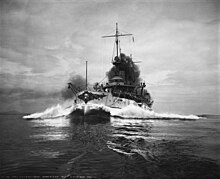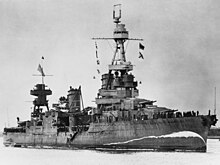Bow wave
This article needs additional citations for verification. (April 2021) |

A bow wave is the wave that forms at the bow of a ship when it moves through the water.[1] As the bow wave spreads out, it defines the outer limits of a ship's wake. A large bow wave slows the ship down, is a risk to smaller boats, and in a harbor can damage shore facilities and moored ships. Therefore, ship hulls are generally designed to produce as small a bow wave as possible.
Description

The size of the bow wave is a function of the speed of the ship, its
The bow wave carries energy away from the ship at the expense of its kinetic energy—it slows the ship. A major goal of naval architecture is therefore to reduce the size of the bow wave and improve the ship's fuel economy. Modern ships are commonly fitted with a bulbous bow to achieve this.
A bow wave forms at the head of a
A similar thing occurs when an airplane travels at the speed of sound. The overlapping wave crests disrupt the flow of air over and under the wings. Just as a boat can easily travel faster than the wave it produces, an airplane with sufficient power can travel faster than the speed of sound (supersonic).

See also
References
- ^ Dictionary. "Bow Wave". Dictionary.com. Retrieved 3 December 2011.
External links
